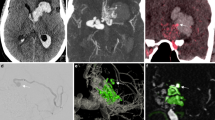Abstract
We obtained the venograms using the two-dimensional digital subtraction angiography (2D DSA) images and three dimensional rotation venography (3D RV) images and investigated the potential usefulness of the 3D RV compared with venograms of 2D DSA using the newly developed three-dimensional rotation angiography unit with a flat-panel detector (FPD). This study included 26 sides (11 left, 15 right) in 20 cases (4 males and 16 females) who underwent radiographic examination for management of intracranial tumors and vascular diseases between May 2003 and December 2003. Each patient underwent diagnostic angiography performed on a DSA unit with a FPD. In all patients, the 2D DSA images, including anteroposterior view and lateral view of the carotid artery, were obtained in two stereoscopic views. The 3D RV was used to produce volume-rendered images. Two neuroradiologists investigated the venous configuration of 3D RV compared with that of 2D DSA about the relationship of the venous drainage system on the temporal lobe according to Guppy et al.’s classification. Twenty-four sides of the 26 sides enabled the precious visualization on 3D RV images. In investigation of 2D DSA, 9 sides (37.5%) were classified into type A, 13 (54.2%) into type B, two (8.3%) into type C, and no sides into types D, E, and F. In investigation of 3D RV images, 10 sides (41.7%) were classified into type A, 9 (37.5%) into type B, 1 (4.2%) into type C, 2 (8.3%) into type E, and 2 (8.3%) into type F. Seven of 24 sides demonstrated discrepancy in results between 2D DSA and 3D RV. The 3D RV could be performed by setting the adequate delay in between the injection of the contrast material and starting time of third rotation to acquire the opacified images. In Guppy et al.’s classification, the 3D RV images could demonstrate the precious venous drainage including the venous lakes with use of multiple views and variable reconstruction compared with 2D DSA. Our DSA system with FPD could provide good 3D RV images. These images are very useful for the skull-base surgery because we can understand the three-dimensional vascular anatomy preoperatively.





Similar content being viewed by others
References
Bidaut LM, Laurent C, Piotin M, Gailloud P, Muster M, Fasel JH, Rufenacht DA, Terrier F (1998) Second-generation three-dimensional reconstruction for rotational three-dimensional angiography. Acad Radiol 5:836–849
Anxionnat R, Bracard S, Ducrocq X, Trousset Y, Launay L, Kerrien E, Braun M, Vaillant R, Scomazzoni F, Lebedinsky A, Picard L (2001) Intracranial aneurysms: clinical value of 3D digital subtraction angiography in the therapeutic decision and endovascular treatment. Radiology 218:799–808
Heautot JF, Chabert E, Gandon Y, Croci S, Romeas R, Campagnolo R, Chereul B, Scarabin JM, Carsin M (1998) Analysis of cerebrovascular diseases by a new 3-dimensional computerized X-ray angiography system. Neuroradiology 40:203–209
Guppy KH, Origitano TC, Reichman OH, Segal S (1997) Venous drainage of the inferolateral temporal lobe in relationship to transtemporal/transtentorial approaches to the cranial base. Neurosurgery 41:615–620
Author information
Authors and Affiliations
Corresponding author
Rights and permissions
About this article
Cite this article
Nishio, A., Takami, T., Ohata, K. et al. Three-dimensional rotation venography using the digital subtraction angiography unit with a flat-panel detector: usefulness for the transtemporal/transtentorial approaches. Neuroradiology 46, 876–882 (2004). https://doi.org/10.1007/s00234-004-1261-8
Received:
Accepted:
Published:
Issue Date:
DOI: https://doi.org/10.1007/s00234-004-1261-8




